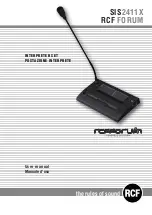
Chapter 12
Triple Modular Processing
Overview
Triple-modular processing is an
enhancement to Kurzweil’s VAST
synthesis model (Variable-
Architecture Synthesis Technology).
The VAST model incorporates
multi-layer programs; each layer in
a VAST program uses an algorithm
that includes pitch control, the
renowned Kurzweil VAST DSP
(digital signal-processing) functions,
and amplitude control. This
provides for a huge number of
combinations.
Triple-modular processing makes
the VAST model even more
fl
exible,
enabling you to create
triple layers
(or just
triples
)—specialized groups of three layers with one
continuous signal path. The audio signal from the
fi
rst layer of a triple gets routed to the second
layer, where it’s mixed with whatever audio signal the second layer may be generating.
Similarly, the output of the second layer is routed to the third layer. The third layer’s output
goes to the input buses of KDFX, then to the physical audio outputs.
This enables you to create sophisticated signal paths and chains of DSP functions. For example,
you can mix the audio signal generated by one layer with the audio signal generated by the
following layer, or you can apply three layers of DSP to the audio signal generated by Layer 1.
There’s an almost limitless number of possible combinations (something like 30
billion
,
depending on how you count).
In Figure 12-2, for example, the processed audio signal from Layer 1 (sample playback and/or
one or more DSP-generated waveforms) gets mixed with the processed audio signal from
Layer 2. The Layer-1 signal gets mixed with the Layer-2 signal just before the third DSP block. If
there were a different algorithm in Layer 2, the Layer-1 signal might get mixed with the Layer-2
signal at a different location, or in multiple locations (both Layer 2 and Layer 3 can have
multiple inputs from the previous layer).
qwwerwwtqwwerwwwwwwerwwtqwwerwwwwwwerwt|
d||||||gk||||||||||||||gk|||||||||||||gh
CVVVVVVBCVVVVVVVVVVVVVVBCVVVVVVVVVVVVVB|
qwwerwwtqwwerwwtqwwerwwwwwwerwwtqwwerwt|
d||||||gk||||||gk||||||||||||||gk|||||gh
CVVVVVVBCVVVVVVBCVVVVVVVVVVVVVVBCVVVVVB|
qwwerwwtqwwerwwwwwwerwwtqwwerwwtqwwerwt|
d||||||gk||||||||||||||gk||||||gk|||||gh
CVVVVVVBCVVVVVVVVVVVVVVBCVVVVVVBCVVVVVB|
Layer-1 algorithm
Layer-2 algorithm
Layer-3 algorithm
Figure 12-1
Algorithms of three possible
normal layers, with three separate
signal paths
Algorithm for
Layer T3 of
triple
Algorithm for
Layer T2 of
triple
Algorithm for
Layer T1 of
triple
qwwerwwtqwwerwwwwwwerwwtqwwerwwwwwwerwt|
d||||||gk||||||||||||||gk|||||||||||||j||
CVVVVVVBCVVVVVVVVVVVVVVBCVVVVVVVVVVVVVM||
qwwerwwtqwwerwwt7wwerwwtqwwerwwwwwwerwwt|
d||||||gk||||||i;||||||gk||||||||||||||j||
CVVVVVVBCVVVVVVBNVVVVVVBCVVVVVVVVVVVVVVM|
||||||||qwwerwwwwwwerwwtqwwerwwtqwwerwt|
||||||||K||||||||||||||gk||||||gk|||||gh|
||||||||CVVVVVVVVVVVVVVBCVVVVVVBCVVVVVB|
Figure 12-2
Algorithm of a possible triple, with a
single
signal path
Содержание K2661
Страница 18: ...2 4 LFOs LFO Shapes...
Страница 34: ...3 16 DSP Algorithms...
Страница 54: ...5 4 MIDI Note Numbers Note Numbers for Percussion Keymaps...
Страница 72: ...7 10 System Exclusive Protocol K2661 System Exclusive Implementation...
Страница 82: ...9 4 Upgrading Sample Memory Choosing and Installing a SIMM for K2661 Sample Memory...
Страница 334: ...10 252 KDFX Reference KDFX Algorithm Specifications...
Страница 340: ...11 6 Glossary...
Страница 382: ...12 42 Triple Modular Processing Alphanumeric Buttonpad Entries for DSP Functions...
Страница 392: ...B 6 SysEx Control of KDFX MSB and LSB...
Страница 442: ...D 20 Contemporary ROM Block Objects Controller Assignments Contemporary ROM Block...
Страница 490: ...H 12 General MIDI Standard Mode Controller Assignments...
Страница 492: ...I 2 Live Mode Objects Live Mode Programs...
Страница 498: ...K2661 Musician s Reference Index...
Страница 500: ......
















































